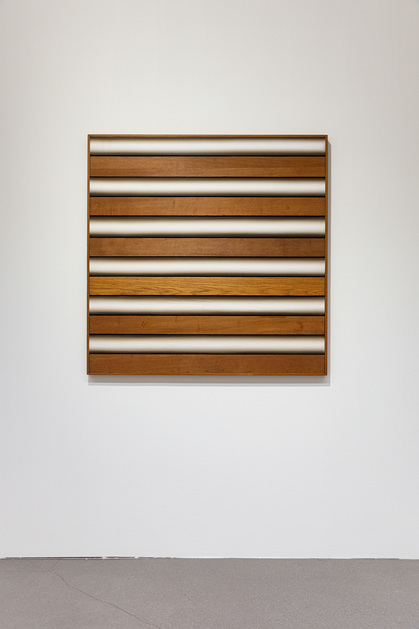-
From Current Issue
-
- Editor’s Letter Fire in the Heart
- Reviews I Gusti Ayu Kadek Murniasih
- Reviews 11th Seoul Mediacity Biennale: “One Escape at a Time”
- Dispatch Networked China
- One on One Monira Al Qadiri on Yukio Mishima
- Essays The rise of independent art spaces in pandemic-era Shanghai
- Features Tuan Andrew Nguyen
- Table of Contents
- Web Exclusives
- Archive
- Subscribe

R
E
V N
E
X
T
Installation view of LEE SEUNG JIO’s “Advancing Columns,” at National Museum of Modern and Contemporary Art (MMCA), Gwacheon, 2020. Courtesy MMCA, Seoul / Gwacheon / Deoksugung / Cheongju.
For many in the Anglophone world, the critical landscape of modern and contemporary art in South Korea comprised two generationally distinct, formally disparate artistic movements. On the one hand is Dansaekwha, represented by the monochrome canvases by the likes of Lee Ufan, Park Seo-bo, and Yun Hyong-keun, brought into historical scrutiny by Joan Kee’s pioneering publications and soon popularized through commercial success at an array of blue-chip galleries. On the other hand is a generation of artists such as Koo Jeong A, Minouk Lim, and Haegue Yang, many of whom spent their formative years in Europe and the United States as South Korea eased its travel restrictions in 1989 and were thus subsequently grouped into discourses surrounding globalization. What unfurled in the years in between the two generations nonetheless remains underexposed, particularly with respect to the status of painting, from which the latter generation shied away. Indeed, the seemingly sterile formalism of Dansaekwha was opposed by loosely grouped, politically oriented artists associated with Minjung art who espoused the narrative potential of the medium, and yet discourses on painting that move beyond the dichotomy of political awareness have proved wanting. Lee Seung Jio’s retrospective “Advancing Columns” at the National Museum of Modern and Contemporary Art, Gwacheon addressed precisely the urgency to eschew these broad historical strokes to chart how the medium was interwoven with the nation’s underexplored avant-gardes, by focusing on the practice of an artist whose conceptual backbone advances existing categorizations.
Leading with paintings in which Lee’s signature motif of the pipe—thick, geometric stripes with minute gradations of hues that offer an appearance of three-dimensionality—have not yet entirely occupied the canvas, the retrospective plots the transformation of his Nucleus series. The earliest works in the exhibition were produced in 1968, six years after Lee and his classmates at Seoul’s Hongik University established the Origin group, which sought to distance themselves from the preceding Informel movement to establish a mode of abstraction based on the reductive capacity of geometry. In these paintings, as well as the ones immediately succeeding them, Lee’s fledgling pipe motifs do not appear to defy the picture plane. In Nucleus 10 (1968), for instance, a flat, multicolored bar of red, white, and black serves as a divider between the off-white canvas on the left and the pitch-black portion on the right. Rather than assert their own presence, then, the motifs in their various configurations are arranged to produce geometric patterns contained within the realms of two-dimensionality. In later paintings, however, the motifs aggressively stress the three-dimensional objecthood of the painting, often engulfing the painting in all-over compositions or imitating its elongated dimensions. In Nucleus (1987), for example, Lee bisects the long, narrow canvas by introducing a pipe motif that is nearly as wide as the remaining swaths of negative space, engendering a tense visual experience in which the motif becomes almost tactile. Such formal logic is reinforced by Danji Lee’s curatorial decision to install the paintings with floor-to-ceiling white aluminum bars that are attached on the verso, at times giving the impression that the pipes penetrate into the space of the exhibition.
Such transitions within Lee’s practice as evinced by the retrospective were satisfying, for they complicate the artist’s conceptual heritage in relation to Dansaekwha as well as mark moments of significance within the history of post-war art in South Korea. Within the exhibition are vitrines that feature exhibition copies of Lee’s sketchbooks as well as ephemera of the Korea Avant-Garde Association (AG), of which he was a founding member along with Kim Kulim and Ha Chong Hyun. These materials contextualize Lee’s ties to Dansaekwha—as notions of Western phenomenology and Japanese Mono-ha were incorporated into the association’s publications—as well as his conception of the pipes as signifiers of urban modernity. Such nascent transcontinental conversations are intimated further in works such as Nucleus 89-30 and Nucleus 89-33 (both 1989), which were produced following the artist’s visit to the United States and incorporated previously unexplored materials such as wood and metal into the painting. In Lee’s paintings, therefore, one could trace bourgeoning vestiges of transnational conversations as well as the broader genealogy of avant-garde artistic experiments in South Korea. Although Lee’s practice was unfortunately forestalled by his premature death at the age of 50, his stalwart paintings unravel these moments of convergence.
Lee Seung Jio’s “Advancing Columns” is on view at the National Museum of Modern and Contemporary Art, Gwacheon, until November 8, 2020.
To read more of ArtAsiaPacific’s articles, visit our Digital Library.















